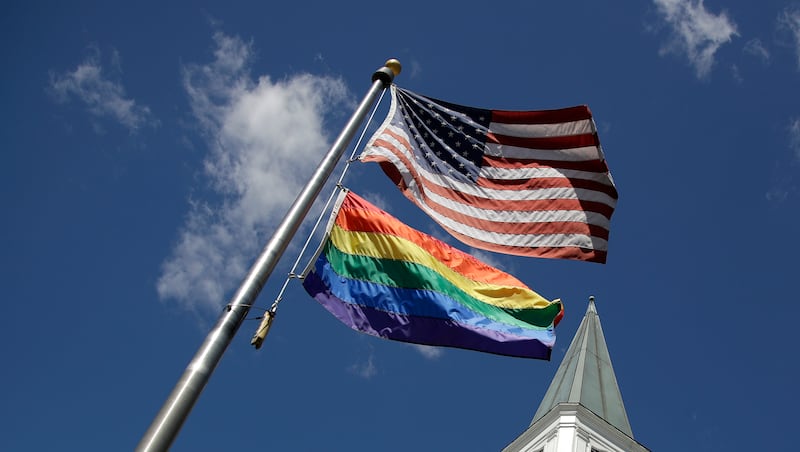When people think of a gay man, they often have an image of a coffee-drinking, well-dressed urbanite with a graduate degree who has never darkened the doorway of a church since he came out to his conservative, religious Midwest parents years ago.
Like any stereotype, there are probably people who fit it. But with more and more surveys including sexual orientation as a question, we are becoming more aware of the diversity of people who identify as gay. While some recognize that there is the occasional person who identifies as gay or lesbian who attends church, it’s easy to assume they are exclusively attending a downtown denomination with a rainbow flag flying in its window where a female pastor gives a homily on global warming.
Again, while this does describe some, sexual and gender minority religiosity is much more diverse and extensive than most people realize. First, belying stereotypes about secular gay people, nearly half of all LGBT individuals in the United States are religious, according to a report by the Williams Institute at UCLA, with 1 in 5 identifying as “highly religious.” Following trends in the society at large, older LGBT people are more religious than younger, and non-white are more religious than white, with a large majority (70%) of Black LGBT people identifying as religious.
Similarly, LGBT people in the South are much more religious than LGBT people in the North, with, for example, 3 out of 4 LGBT people in South Carolina identifying as moderately or very religious. So while, yes, there are gay Ph.D.s living in New York City who are in the stereotypically gay professions and who have not attended church in years, so too are there gay loggers and ranchers who attend church religiously.
But which church? While there are some churches that are not heteronormative — that is, they ordain sexually active gay clergy, solemnize same-sex marriages and do not treat homosexual behavior as a sin — they are in the minority. Furthermore, in a study I published a few years ago, I found that more sexual minorities affiliated with heteronormative faiths than non-heteronormative ones. So even among gay parishioners, those attending the rainbow-flag waving services are the exception, not the rule. Most go to more traditional churches.
But why? While some might see a contradiction inherent in sexual minorities attending a heteronormative faith, one study of Black, gay religious men found that many preferred their more traditional churches for a variety of reasons.
For example, some may not want to base their religious experience so centrally on their sexuality, some just because they were raised with it and feel more comfortable, their orientation and its teachings notwithstanding, with one respondent stating that “I just prefer — I just want to stay with what I know, my regular old church, as long as he’s not at the pulpit telling me I’m going to go to hell. I don’t want — I think some people may feel like it’s kind of like playing around with religion in some aspects.”
That’s not to say that some churches oriented specifically toward sexual minorities don’t have their place. For example, in Africa, a church in Kenya geared specifically toward gender and sexual minorities has been serving a community that has faced violence and abuse for over a decade (and has had to move 10 times).
While sexual minorities are less religious generally, even outside of formal religious practice, the vast majority of sexual minorities hold some kind of spiritual beliefs about God, and may pray even if they are not formally religious. I took the past 10 years of the General Social Survey, a large, nationally representative survey that asks a wide variety of questions, including some dealing with religious beliefs as well as sexual orientation, and calculated how many LGB Americans believe in God, finding that:
-
Only 11% of LGB Americans are atheists, and simply do not believe in God.
-
Twelve percent have a position that is somewhat agnostic, stating that they don’t know, and there is no way to find out.
-
Twenty-one percent indicated that they believed in a “higher power.”
-
Six percent indicated that they “believe sometimes.”
-
Twenty-one percent indicated that they believe but occasionally doubt.
-
Twenty-nine percent believe in God and have no doubt about it.
In other words, about half of all LGB believe in God; if the “higher power” option is included, that number grows to 70%, with only about 1 in 4 being atheists or agnostics. The belief in a personal God is also demonstrated by looking at how often they pray. According to the same survey, over 1 in 3 people identifying as LGB (transgender was not included as an option in the survey) in the United States pray daily and only a little less than 1 in 3 “never” pray. In terms of religious services attendance, about 1 in 5 of sexual minorities attend “about once a month” or more, and a minority (44%) attend “never.”
According to the same GSS survey, about 6% of the U.S. population identifies as gay, lesbian or bisexual. Since according to the U.S. Census there are 341 million people in the United States, that would equate to 20.5 million LGB-identifying people, according to the GSS survey, and 4 million LGB people attending religious services at least once per month, and at least 6.8 million prayers ascending to heaven from the U.S. every day from this same group of men and women.
Of course, they are not “LGBT+ prayers” any more than other prayers are heterosexual prayers. As Elder David A. Bednar has said, “We are not defined by sexual attraction. We are not defined by sexual behavior. We are sons and daughters of God.” As shown by the findings in the study above, for many sexual minorities, their lived religion is not reducible to how it interfaces with that one particular part of their identity, instead encompassing the totality of their relationship with God.


